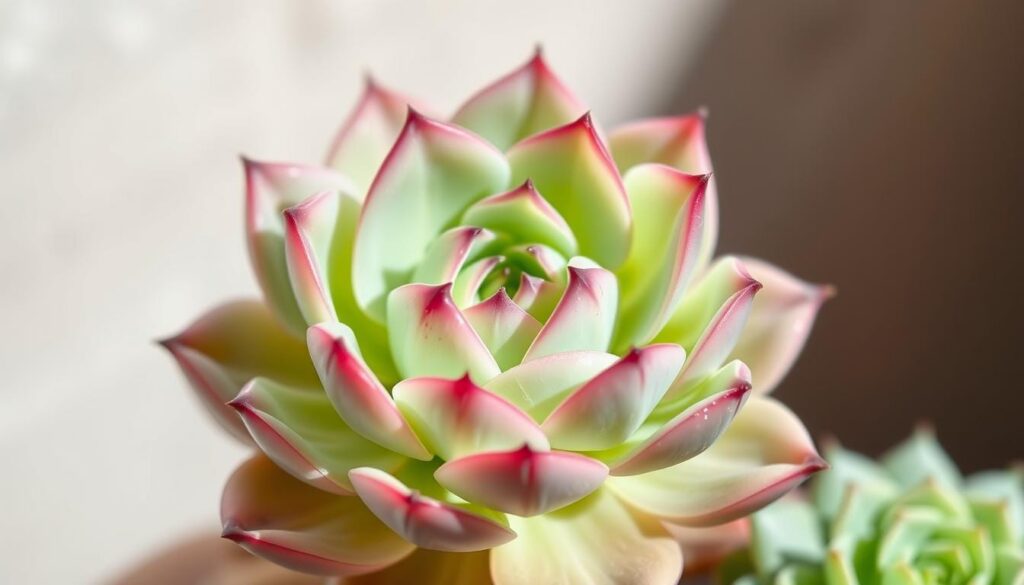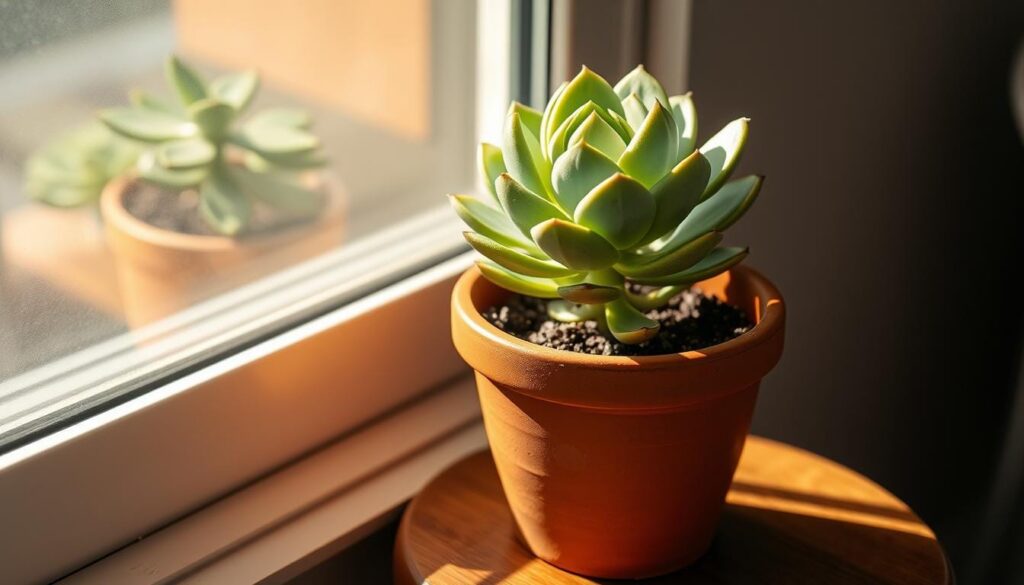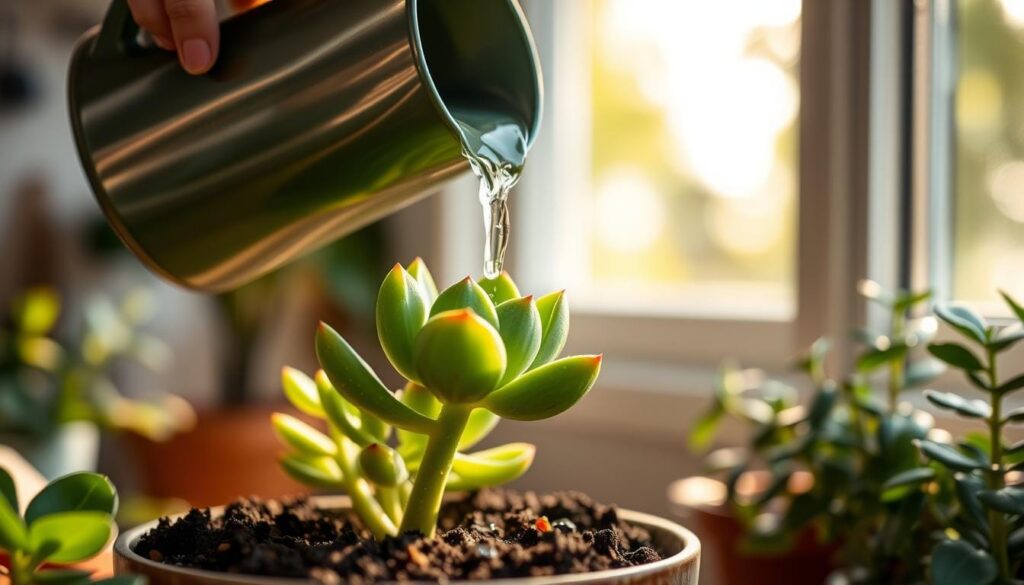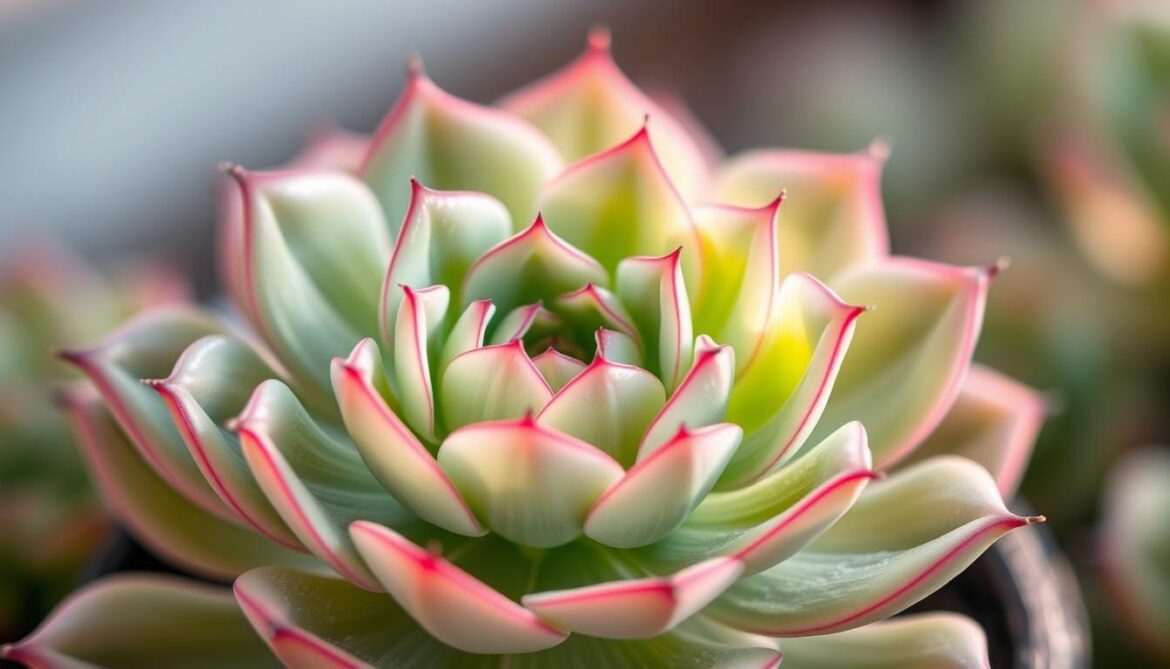For many plant enthusiasts, the Echeveria ‘Lola’ is one favorite addition to their collection. This beautiful rosette-forming succulent boasts pale gray-blue leaves, often tinged with pink, and peach or salmon-colored flowers that bloom in the summer.
Growing Echeveria ‘Lola’ requires attention to its soil requirements, light conditions, and watering techniques. As a hybrid between Echeveria lilacina and Echeveria derenbergii, cultivated by Dick Wright, Lola can grow to be about 6″ wide and 4-6″ tall, making it a stunning addition to any succulent arrangement.
Understanding how to care for this plant is essential for keeping it healthy and thriving. Whether you’re a beginner or an experienced grower, this guide will cover everything you need to know about growing and caring for your Echeveria ‘Lola’.
Key Takeaways
- Understand the specific soil requirements for Echeveria ‘Lola’
- Learn the optimal light conditions for healthy growth
- Master the right watering techniques to prevent common issues
- Discover how to propagate your Echeveria ‘Lola’ effectively
- Explore tips for maintaining the plant’s vibrant color and health
Understanding the Lola Succulent

The Echeveria ‘Lola’ succulent is a hybrid plant that combines the best traits of its parent species, Echeveria lilacina and Echeveria derenbergii.
What is Echeveria ‘Lola’?
Echeveria ‘Lola’ is a stunning hybrid succulent created by renowned breeder Dick Wright. It features a beautiful, rosette-shaped form with pale gray-blue leaves coated in a thick layer of epicuticular wax.
Distinctive Features and Appearance
The rosette formation of Lola succulents is characterized by neatly arranged leaves in a circular pattern. The leaf margins take on a pinkish hue when exposed to bright light or colder temperatures.
Benefits of Growing Lola Succulents
Growing Lola succulents offers several benefits, including air purification, low maintenance requirements, and drought tolerance. These plants thrive in various soil conditions and require minimal attention over time, making them perfect for busy gardeners.
- Air purification and low maintenance
- Drought tolerance and adaptability to different soil conditions
- Year-round visual interest with minimal growth demands
Ideal Growing Conditions for Lola Succulent

To keep your Lola succulent thriving, it’s essential to understand its ideal growing conditions. This includes providing the right amount of light, maintaining an optimal temperature, and using the appropriate soil and potting mix.
Light Requirements
Lola succulents thrive in bright, indirect light conditions. They require at least 6 hours of sunlight daily to maintain their compact rosette shape and vibrant coloration. When grown indoors, place your plant near a south-facing window for optimal light exposure. If adequate natural light isn’t available, consider using a grow light specifically designed for succulents.
When transitioning your Lola succulent outdoors, gradually acclimate it to direct sunlight to prevent leaf burn. Start with morning sun exposure and gradually increase the duration over time.
Temperature and Climate Needs
These plants prefer temperatures between 65-80°F (18-27°C) during the growing season. They can tolerate cooler temperatures down to 20°F (-6°C), making them suitable for USDA hardiness zones 9-11. Avoid exposing your Lola succulent to freezing conditions, as this can cause damage.
Soil and Potting Requirements
Proper soil drainage is crucial for Lola succulents. Use a specialized potting soil designed for cacti and succulents, which typically contains coarse materials like perlite, pumice, or coarse sand. You can also create your own optimal soil mixture by combining regular potting soil with equal parts perlite and coarse sand.
Best Soil Mixtures
A good soil mixture should have lots of perlite or vermiculite for drainage and some organic matter for nutrition. Adding a few handfuls of perlite to regular store-bought cactus soil can enhance drainage and prevent waterlogged soil.
Choosing the Right Container
Always select containers with drainage holes to prevent water accumulation around the roots. Terracotta or unglazed clay pots are ideal choices, as they allow the soil to dry more quickly between watering sessions and provide stability for top-heavy plants.
Proper Care and Maintenance

To keep your Lola succulent thriving, it’s essential to understand the proper care and maintenance techniques. This includes providing the right watering, seasonal adjustments, and propagation methods.
Watering Techniques
Watering is a critical aspect of caring for your Lola succulent. The “soak and dry” method is recommended, where you thoroughly water the plant until it drains from the bottom, then allow the soil to completely dry before watering again.
How Often to Water
For most environments, Lola succulents typically need watering every 10-14 days during growing seasons (spring and summer). During dormant winter periods, watering can be reduced to every 3-4 weeks.
Avoiding Common Watering Mistakes
Common mistakes include maintaining a regular watering schedule rather than checking soil moisture, using spray bottles that encourage shallow root growth, and watering during the hottest part of the day. Always water at the soil level to prevent water from collecting between leaves or in the rosette center.
Seasonal Care Adjustments
Seasonal care adjustments are essential for Echeveria ‘Lola’. Reduce watering in winter when growth naturally slows, provide additional light during shorter days, and resume normal care in spring when active growth resumes. For more information on caring for succulents in different seasons, you can visit this guide on planting prickly pear.
Propagation Methods
Lola succulents can be easily propagated through leaf cuttings, allowing cut leaves to callus before placing on soil, or offsets by removing and replanting “pups” that form around the base. They can also be grown from seeds after flowering.
Troubleshooting Common Problems
Monitor your plants regularly for signs of stress in the leaves, such as yellowing, wrinkling, or unusual spotting, which often indicate watering issues or pest problems. Common pests include mealybugs and aphids, which can be treated with isopropyl alcohol or insecticidal soap.
Dealing with Pests
Mealybugs and aphids can be treated by applying isopropyl alcohol directly to the affected area with a cotton swab or using insecticidal soap for larger infestations.
Addressing Leaf Issues
Leaf issues like etiolation (stretching) indicate insufficient light and require gradually moving the plant to a brighter window or supplementing with grow lights. Root rot, evidenced by blackening stems and translucent leaves, requires immediate intervention by removing affected parts and replanting in fresh cactus soil.
Conclusion
To summarize, growing Echeveria Lola requires attention to its specific needs, but the payoff is well worth the effort. By providing well-draining soils and appropriate light conditions, you can enjoy a thriving Lola succulent with stunning rosette formations.
With their low water requirements and striking appearance, Echeveria succulents are an excellent choice for succulent enthusiasts. By following the guidelines outlined in this article, you’ll be well on your way to growing healthy, beautiful succulents that will enhance any plant collection.

